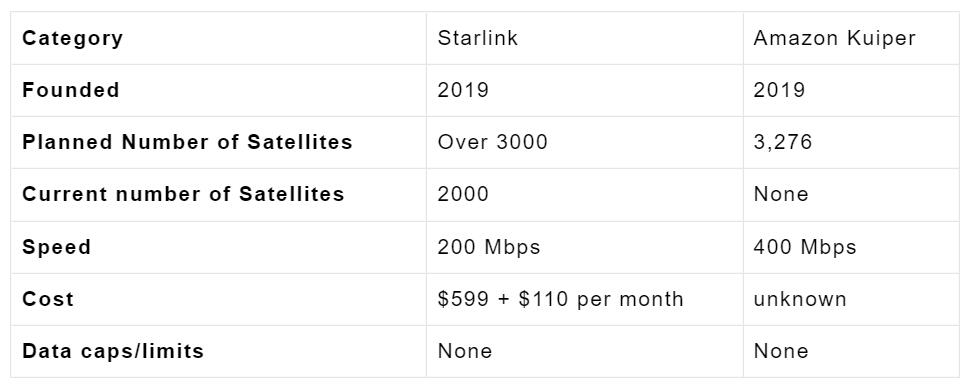The 21st century has seen humanity leave Earth’s orbit and establish a permanent presence in space. With private companies now leading the charge, exploration and exploitation of space resources have become big business. The race is on to build the infrastructures needed to support this new industry, and two of the biggest players are Amazon Kuiper vs. Starlink. So, who will come out on top?
Table of Contents
- What is Starlink?
- What is Amazon’s Project Kuiper, and how does Project Kuiper work? What is the purpose of Project Kuiper?
- Starlink vs. Amazon Kuiper
- The Benefits and Issues of Satellite Internet
- FAQs
- Conclusion
What is Starlink?
Starlink is a satellite constellation constructed by SpaceX, providing satellite Internet access. The satellite constellation will have many small satellites flying low in the Earth’s orbit (LEO), working with ground transceivers.
The system provides a high-speed broadband Internet connection with low latency for users anywhere on the planet.

Concept of high-speed network
What is Amazon’s Project Kuiper, and how does Project Kuiper work? What is the purpose of Project Kuiper?
Amazon’s Kuiper is a proposed set of three thousand satellites that would orbit the Earth and provide broadband internet access to all of its inhabitants. The project is still in its early stages but will be the largest satellite constellation ever created.
One of the primary purposes of Project Kuiper is to provide internet access to people living in rural or remote areas with a minimum speed of 25Mbps. Like every other company, Kuiper’s main goal is to make profits by lowering the prices compared to its competitors. This, of course, is an advantage to customers as there will be competition in the market. Thus, services will be improved.

network technology at high mountain outback wasteland outdoor
Starlink vs. Amazon Kuiper

Orbit Altitude
Starlink satellites orbit at an altitude of 550 kilometers, while Kuiper satellites will orbit at an altitude of 590 kilometers. Both companies operate in low earth orbit.
Satellite Launches and Deployment
SpaceX Falcon rockets launch Starlink satellites, while Blue Origin New Glenn rockets launch Kuiper.

Launch of the rocket into the space
The Falcon rocket can carry up to 60 Starlink satellites simultaneously. Amazon, on the other, is not clear how many satellites the New Glenn rocket can carry. But a payload of 45 metric tons carries quite the load.
Ground Stations
Starlink and Kuiper will require a network of ground stations to communicate with the satellites. Starlink will use existing SpaceX ground stations, while Kuiper is yet to announce the number of stations they will build.
User Hardware
Starlink costs $599 upfront for a user terminal. Amazon has, however, not released prices for the hardware yet.
Service Availability/Scope
Starlink and Kuiper plan to provide global coverage on reaching full capacity. Starlink is available in service, while Kuiper still takes time.

Network and Connection technology
Performance
Starlink speed hit 200 gigabits per second, while Kuiper will initially only be able to provide speeds of up to 400 megabits per second.
ISP Differences
Both Kuiper and Starlink are internet service providers (ISPs). It means that they might cause some privacy concerns among some users. Amazon plans to use AWS facilities already in place as hubs of communication.
Amazon already has some of its users’ information stored in its cloud servers as an ISP. It will therefore provide customers more convenience.
Amazon Kuiper vs. Starlink: Physical Tech Differences
Amazon has not provided any of its tech for scrutiny. Therefore, there is nothing customers can use to connect to the network. On the other hand, Starlink provides its customers with a router, an ethernet cable, and an antenna to receive the signal from the satellites.
The Benefits and Issues of Satellite Internet
Satellite internet has a lot of advantages. The most notable is the usage in remote areas where other internet options are unavailable and offer relatively high speeds.
However, there are also some disadvantages to using satellite internet. One of the biggest is the high cost of the service and the hardware required to use it. In addition, satellite internet can be unreliable due to factors beyond your control, such as bad weather.
FAQs
Amazon Kuiper vs. Starlink: How fast will Amazon Internet be?
The top speed for Kuiper is 400 megabits per second. Amazon announced that they are planning to offer even faster speeds eventually.
Amazon Kuiper vs. Starlink: How many satellites are on Amazon Kuiper?
The Amazon plans to have 3276 satellites in the Amazon Kuiper constellation. However, as of 2022, they have not yet provided a date for their initial satellite launches.
Amazon Kuiper vs. Starlink: Where is Amazon Kuiper located?
The Amazon Kuiper team has plans to move to a new facility in Redmond, WA, where they will set up the headquarters and manufacturing unit. This is after the project outgrew its current facility.

Earth view from space and satellite
Amazon Kuiper vs. Starlink: Can Amazon compete with SpaceX in the satellite internet business?
Most remote users found a fast, reliable, quality service in Starlink. Amazon Kuiper will give it a run for its money as it has also carved out the same niche. If the prices are competitive, Kuiper will grab some market share.
Conclusion
So, which satellite internet system is better in the Amazon Kuiper vs. Starlink battle? It might be too early to tell as Amazon has not started operations yet. Judging by its technology, however, it is clear that it will bring much-needed competition to the satellite internet market. This competition will go a long way in ensuring the customer is always kept first.
